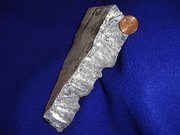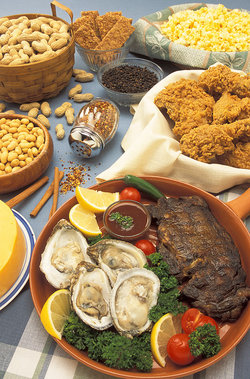|
|||||
| General | |||||
|---|---|---|---|---|---|
| Name, Symbol, Number | zinc, Zn, 30 | ||||
| Chemical series | transition metals | ||||
| Group, Period, Block | 12, 4, d | ||||
| Density, Hardness | 7140 kg/m3, 2.5 | ||||
| Appearance | blueish pale grey |
||||
| Atomic properties | |||||
| Atomic weight | 65.409 amu | ||||
| Atomic radius (calc.) | 135 (142) pm | ||||
| Covalent radius | 131 pm | ||||
| van der Waals radius | 139 pm | ||||
| Electron configuration | [Ar]3d104s2 | ||||
| e- 's per energy level | 2, 8, 18, 2 | ||||
| Oxidation states (Oxide) | 2 (amphoteric) | ||||
| Crystal structure | hexagonal | ||||
| Physical properties | |||||
| State of matter | solid (diamagnetic) | ||||
| Melting point | 692.68 K (419.52 ºC / 787.15 °F) | ||||
| Boiling point | 1180 K (907.2 ºC / 1665 °F) | ||||
| Molar volume | 9.16 ×10-6 m3/mol | ||||
| Heat of vaporization | 115.3 kJ/mol | ||||
| Heat of fusion | 7.322 kJ/mol | ||||
| Vapor pressure | 192.2 Pa at 692.73 K | ||||
| Velocity of sound | 3700 m/s at 293.15 K | ||||
| Miscellaneous | |||||
| Electronegativity | 1.65 (Pauling scale) | ||||
| Specific heat capacity | 390 J/(kg*K) | ||||
| Electrical conductivity | 16.6 106/(m·ohm) | ||||
| Thermal conductivity | 116 W/(m*K) | ||||
| 1st ionization potential | 906.4 kJ/mol | ||||
| 2nd ionization potential | 1733.3 kJ/mol | ||||
| 3rd ionization potential | 3833 kJ/mol | ||||
| 4th ionization potential | 5731 kJ/mol | ||||
| SI units & STP are used except where noted. | |||||
Zinc is a chemical element in the periodic table that has the symbol Zn and atomic number 30.
Notable characteristics
Zinc is a moderately reactive metal that will combine with oxygen and other non-metals, and will react with dilute acids to release hydrogen. The one common oxidation state of zinc is +2.
Applications
Zinc is the fourth most common metal in use, trailing only iron, aluminium, and copper in tons of metal produced per year.
- Zinc is used to galvanize metals such as steel to prevent their corrosion.
- Zinc is used in alloys such as brass, nickel silver, typewriter metal, various solder formulas, German silver, etc.
- Brass, in turn, has wide application because of its strength and corrosion resistance.
- Zinc is used in die castings, especially by the automobile industry.
- Rolled zinc is used as part of the containers of batteries.
- Zinc oxide is used as a white pigment in watercolors and paints, and as an activator in the rubber industry. As an over-the-counter ointment, it is applied as a thin coating on the exposed skin of the face and nose to prevent dehydration and thereby protect against sunburn in the summer and windburn in the winter. Applied thinly to a baby's diaper area (perineum) with each diaper change, it protects against rash. As determined in the Age-Related Eye Disease Study, it's part of an effective treatment for age-related macular degeneration in some cases.
- Zinc chloride is used as a deodorant and as a wood preservative.
- Zinc sulfide is used in luminescent pigments, for making the hands of clocks and other items that glow in the dark.
- Zinc methyl (Zn(CH3)2) is used in a number of organic syntheses.
- Lotions made of calamine, a mix of Zn-(hydroxy-)carbonates and silicates, are used to treat skin rash.
- Zinc metal is included in most proprietary over-the-counter daily vitamin and mineral preparations. Along with some other metals, it is commonly believed to possess anti-oxidant properties, which protect against premature aging of the skin and muscles of the body. In larger amounts, taken as zinc alone in other proprietaries, it is believed to speed up the healing process after an injury.
- Zinc gluconate glycine is taken in lozenge form as a remedy for the common cold.
History

Zinc alloys have been used for centuries, as brass goods dating to 1000-1400 BC have been found in Palestine and zinc objects with 87% zinc have been found in prehistoric Transylvania. Because of the low boiling point and chemical reactivity of this metal (isolated zinc would tend to go up the chimney rather than be captured), the true nature of this metal was not understood in ancient times.
The manufacture of brass was known to the Romans by about 30 BC, using a technique where calamine and copper were heated together in a crucible. The zinc oxides in calamine were reduced, and the free zinc metal was trapped by the copper, forming an alloy. The resulting brass was either cast or hammered into shape.
Smelting and extraction of impure forms of zinc was being accomplished as early as AD 1000 in India and China. By the end of the 14th century, the Hindus were aware of the existence of zinc as a metal separate from the seven known to the ancients. In the West, the discovery of pure metallic zinc is most often credited to the German Andreas Marggraf, in the year 1746, though the whole story is considerably more involved.
Descriptions of brass manufacture are found in Western Europe in the writings of Albertus Magnus, c. 1248, and by the 16th century, the understanding and awareness of the new metal broadened considerably. Agricola observed, in 1546, that a white metal could be condensed and scraped off the walls of a furnace when zinc ores were smelted. He added in his notes that a similar metal called "zincum" was being produced in Silesia. Paracelsus (died 1541) was the first in the West to say that that "zincum" was a new metal and that it had a separate set of chemical properties from other known metals.
The upshot is that zinc was known by the time Marggraf made his discoveries and in fact zinc had been isolated two years earlier by another chemist, Anton von Swab. However, Marggraf's reports were exhaustive and methodical and the quality of his research cemented his reputation as the discoverer of zinc.
Before the discovery of the zinc sulfide flotation technique, calamine was the mineral source of zinc metal.
Biological role
Zinc is an essential element in human beings, necessary for sustaining life. Deficiencies of zinc have marked effects on weight gain in animals. Zinc is found in insulin, zinc finger proteins, and such enzymes as superoxide dismutase.
According to some sources, taking zinc tablets may provide some immunity against colds and flu, although this is disputed.
Eyesight, taste, smell and memory are also connected with zinc and a deficiency in zinc can cause malfunctions of these organs and functions.
Natural food sources of zinc include oysters, red meat and poultry, beans, nuts, whole grains, pumpkin seed or sunflower seeds.
In males, zinc is important for the production of semen. Up to 5 mg of zinc is lost during ejaculation. Deficiencies in zinc in males can lead to reduced sperm count and sex drive. Frequent ejaculations can lead to zinc defiency.
Abundance
Zinc is the 23rd most abundant element in the earth's crust. The most heavily mined ores tend to contain roughly 10% iron as well as 40-50% zinc. Minerals from which zinc is extracted include sphalerite, zinc blende, smithsonite, calamine, and franklinite.
There are zinc mines throughout the world, with the largest producers being Australia, Canada, China, Peru and the U.S.A. Mines in Europe include Vieille Montagne in Belgium and Zinkgruvan in Sweden.Compounds
Zinc oxide is perhaps the best known and most widely used zinc compound, as it makes a good base for white pigments in paint. It also finds industrial use in the rubber industry, and is sold as opaque sunscreen. A variety of other zinc compounds find use industrially, such as zinc chloride (in deodorants), zinc sulfide (in luminescent paints), and zinc methyl in the organic laboratory. Roughly one quarter of all zinc output is consumed in the form of zinc compounds.
Isotopes
Naturally occurring zinc is composed of the 4 stable isotopes Zn-64, Zn-66, Zn-67, and Zn-68 with 64 being the most abundant (48.6% natural abundance). 22 radioisotopes have been characterized with the most {abundant and/or stable} being Zn-65 with a half-life of 244.26 days, and Zn-72 with a half-life of 46.5 hours. All of the remaining radioactive isotopes have half-lives that are less than 14 hours and the majority of these have half lives that are less than 1 second. This element also has 4 meta states.
Precautions
Metallic zinc is not considered to be toxic, but there is a condition called zinc shakes or zinc chills that can be induced by the inhalation of freshly formed zinc oxide. Excessive intake of zinc can promote deficiency in other dietary minerals.
References
- Los Alamos National Laboratory - Zinc (http://periodic.lanl.gov/elements/30.html)


